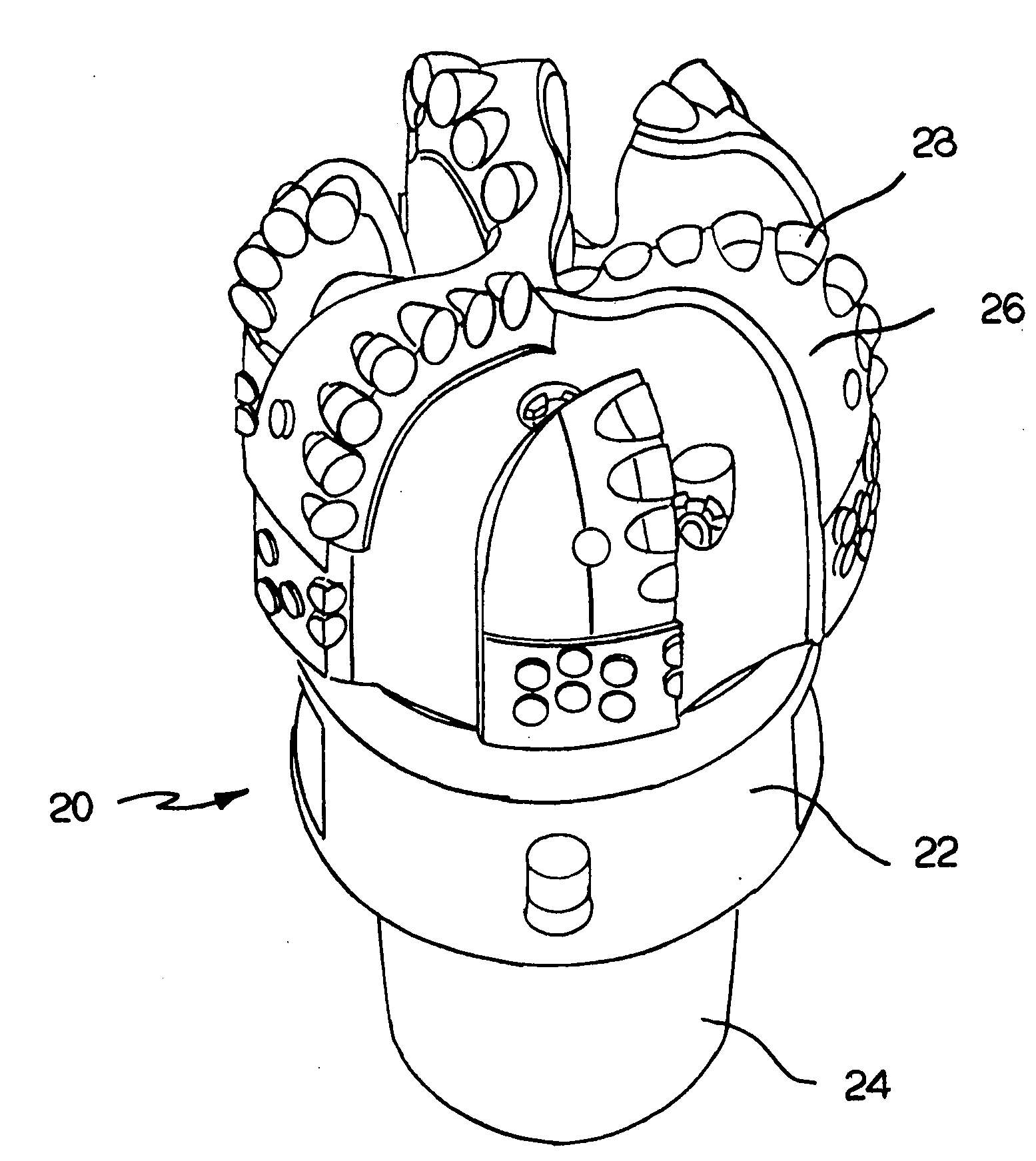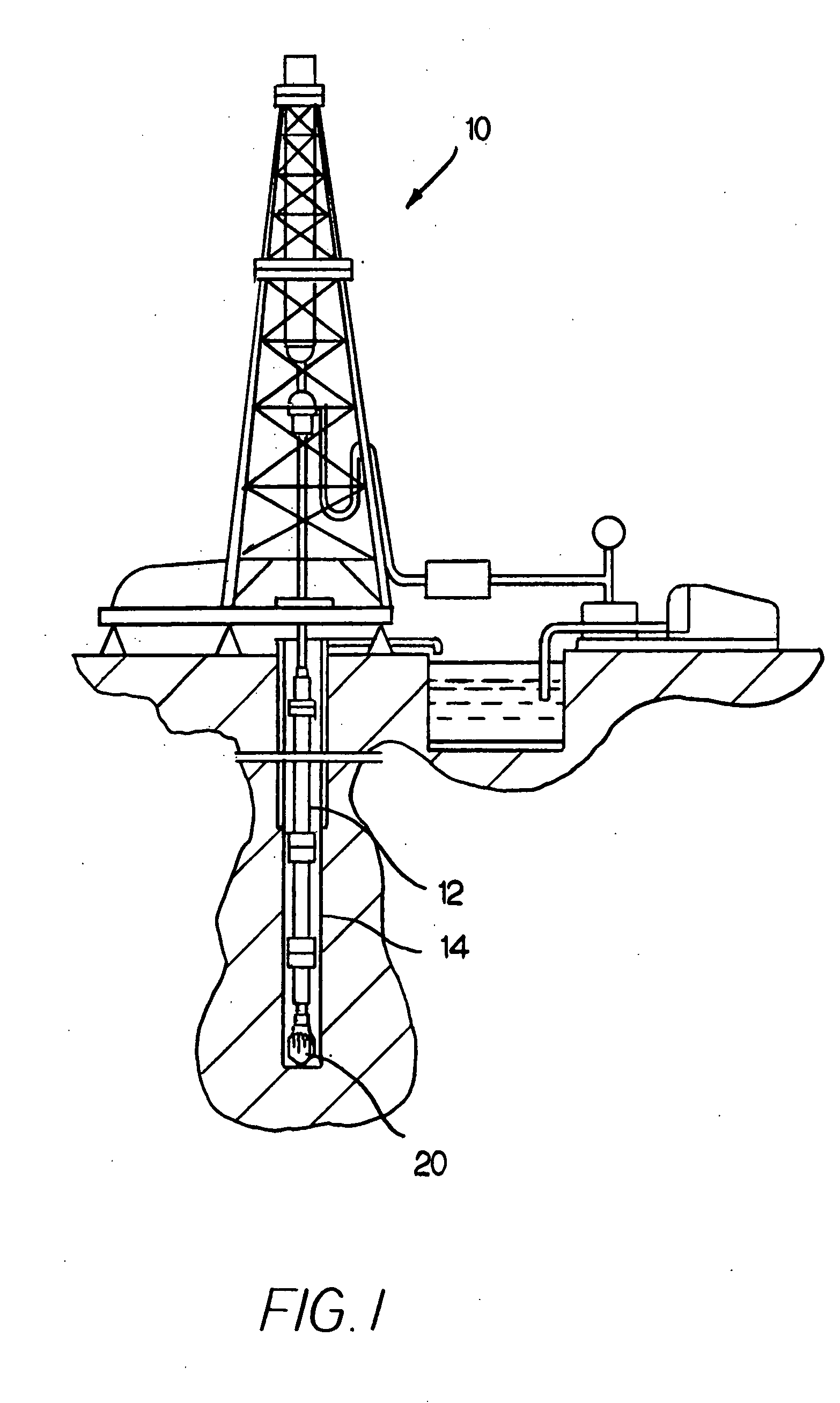Fixed cutter bit and blade for a fixed cutter bit and methods for making the same
a technology of fixed cutters and fixed blades, which is applied in the direction of drill bits, cutting machines, earth-moving drilling and mining, etc., can solve the problems of abrasive wear, bit body and other elements of earth-moving bits are subjected to many forms of wear, and the most common form of wear
- Summary
- Abstract
- Description
- Claims
- Application Information
AI Technical Summary
Benefits of technology
Problems solved by technology
Method used
Image
Examples
second embodiment
[0053]FIG. 3A is a side view of a single blade 40 from a fixed cutter bit along the lines of FIG. 2 with the PDC cutter elements removed from the blade so as to expose the grooves 42 in the blade. The blade 40 comprises a leading portion 44 and a trailing portion 46 joined to the leading portion 44.
[0054]In this specific embodiment, the leading portion 44 of the blade 40 comprises cemented carbide (e.g., cemented (cobalt) tungsten carbide) and the trailing portion 46 of the blade 40 comprises steel. The leading portion 44 and trailing portion 46 can be joined together by any one of a number of techniques including without limitation brazing techniques and infiltration techniques. Although it will be discussed in more detail hereinafter, the blade 40 is joined at the radial inward edge 48 thereto the cutter bit body by any one of a number of techniques including without limitation brazing techniques, infiltration techniques, press fitting techniques, shrink fitting techniques, weldin...
third embodiment
[0055]FIG. 3B is a side view of a single blade 50 from a fixed cutter bit along the lines of FIG. 2 with the PDC cutter elements removed from the blade so as to expose the grooves 52 in the blade 50. The blade 50 has a leading portion 54 and a trailing portion 56 that are joined together. The leading portion 54 of the blade 50 comprises steel. The trailing portion 56 of the blade 50 comprises cemented carbide (e.g., cemented (cobalt) tungsten carbide). The leading portion 54 and trailing portion 56 can be joined together by any one of a number of techniques including without limitation brazing techniques and infiltration techniques. Although it will be discussed in more detail hereinafter, the blade 50 is joined at the radial inward edge 58 thereto the cutter bit body by any one of a number of techniques including without limitation brazing techniques, infiltration techniques, press fitting techniques, shrink fitting techniques, welding techniques, and mechanical technical technique...
fourth embodiment
[0057]FIG. 4A is a side view of a single blade 60 from a fixed cutter bit along the lines of FIG. 2 with the PDC cutter elements removed from the blade 60 so as to expose the grooves 62 in the blade 60. The blade 60 has a leading portion 64 that is joined together with a trailing portion 66. In this embodiment, the leading portion 64 of the blade 60 comprises cemented carbide (e.g., cemented (cobalt) tungsten carbide) and the trailing portion 66 of the blade 60 comprises a hard component-matrix composite material. The hard component-matrix composite material will be described in more detail hereinafter. The leading portion 64 and trailing portion 66 can be joined together by any one of a number of techniques including without limitation brazing techniques and infiltration techniques. Although it will be discussed in more detail hereinafter, the blade 60 is joined at the radial inward edge 68 thereto the cutter bit body by any one of a number of techniques including without limitatio...
PUM
| Property | Measurement | Unit |
|---|---|---|
| melting point | aaaaa | aaaaa |
| melting point | aaaaa | aaaaa |
| surface area | aaaaa | aaaaa |
Abstract
Description
Claims
Application Information
 Login to View More
Login to View More - R&D
- Intellectual Property
- Life Sciences
- Materials
- Tech Scout
- Unparalleled Data Quality
- Higher Quality Content
- 60% Fewer Hallucinations
Browse by: Latest US Patents, China's latest patents, Technical Efficacy Thesaurus, Application Domain, Technology Topic, Popular Technical Reports.
© 2025 PatSnap. All rights reserved.Legal|Privacy policy|Modern Slavery Act Transparency Statement|Sitemap|About US| Contact US: help@patsnap.com



